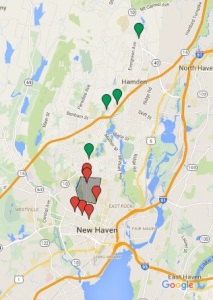By Melissa Barclay
For Lezlie McEachern, a student who grew up in the Newhallville area of New Haven, healthy food was not always a priority. Newhallville is considered a “food desert,” and McEachern’s family struggled with a hectic schedule, lack of knowledge about nutritious food and transportation issues.
According to the USDA, a food desert is defined as an area that lacks healthy produce. Residents within these areas are also more than a mile and a half from a grocery store or supermarket, and lack reliable transportation.
“If you told me I lived in a food desert, I would be very confused — my family would be confused. Honestly, I would keep eating the same — it was cheap,” McEachern said.
McEachern was within walking distance to a bodega and a Chinese takeout restaurant. She frequented them in high school and sometimes when she goes home.
The word “bodega” is Spanish for corner store. They sell some items that can be found in the grocery store, such as milk and bread — but often at higher prices. Although those items are available, it is still cheaper to buy the unhealthier options, such as prepared fast food such as a cheese steak, or fries.
“My favorite thing to get was a beef patty on a hard roll. I also loaded up with snacks for lunch and all throughout the day — I hated the school lunch,” McEachern said.
McEachern’s high school schedule started with first period at 7:55 a.m. McEachern skipped breakfast. Lunch was from the bodega a few blocks down. A beef patty on a hard roll and snacks such as Little Debbie cakes held her over for the day.
“After school, if it was cheerleading season, we would go get something to eat. It would be like pizza, Chinese, or subs. It was never anything healthy. Everything was close,” McEachern said.
Growing up, McEachern’s family attempted to be nutritious. They were aware that diabetes, high cholesterol and high blood pressure ran in the family, and wanted to clean up their diet. But there were financial pressures, and eating healthy was more expensive.
As a result of her poor diet, McEachern’s health began to suffer. Her weight increased, and she felt sluggish. She admitted that a lack of education on what she ate contributed.
“I was really aware of how much my weight changed. I felt sluggish and tired all the time. I didn’t realize it was because of my diet until now,” she said.
At the time, McEachern’s family only had one car. It was mainly used by her father, who worked in North Haven. Her mother worked in New Haven and took the city bus to work. McEachern also took the bus.
“My father often worked late, and was tired by the time he came home,” McEachern said. “By that time, I had already gotten something from the bodega, and my mother cooked dinner, but I usually never ate it.”
To combat issues faced by families such as McEachern’s, and more severe cases, the New Haven Food Policy Council created a “Food Action Plan” in 2012 aimed at creating a healthier “food system” for the city.
Goals include increasing access to healthy food for New Haven residents and encouraging healthy food choices by educating residents.
Events such as a community potluck, cooking classes featuring nutritious food, and gardening activities have been held so far.
“I do think there needs to be programs that educate people in food deserts about nutritious food,” McEachern said. “But I wish more people knew about it. My family didn’t, my friends — they need to push it more.”
Melissa Barclay is a senior journalism student at Quinnipiac University. She is writing about food deserts this spring. She can be reached at melissa.barclay@quinnipiac.edu.

